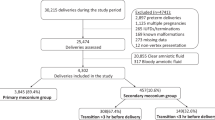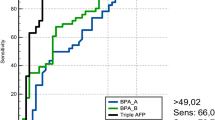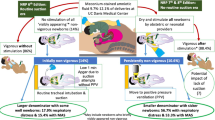Abstract
OBJECTIVE: To determine if amnioinfused normal saline or lactated Ringer's solution in cases of meconium-stained amniotic fluid is associated with significant changes on neonatal plasma electrolyte concentrations or pH.
STUDY DESIGN: This was a prospective randomized study using normal saline or lactated Ringer's solution for amnioinfusion in women with thick meconium in the amniotic fluid. The control group was composed of women with clear amniotic fluid not receiving amnioinfusion. Cord blood arterial sampling was analyzed for sodium, potassium, and chloride plasma concentrations and pH. The sample sizes allowed for an α of 0.05 and power of 0.80.
RESULTS: We evaluated 61 cases (20 normal saline solution, 20 lactated Ringer's solution, and 21 control). No significant differences in cord blood arterial plasma concentrations of sodium (p=0.43), potassium (p=0.21), chloride (p=0.68), and pH (p=0.11) were noted.
CONCLUSION: Use of normal saline or lactated Ringer's solution for amnioinfusion in meconium-stained amniotic fluid is not associated with changes on neonatal plasma electrolyte concentrations or pH.
This is a preview of subscription content, access via your institution
Access options
Subscribe to this journal
Receive 12 print issues and online access
$259.00 per year
only $21.58 per issue
Buy this article
- Purchase on Springer Link
- Instant access to full article PDF
Prices may be subject to local taxes which are calculated during checkout
Similar content being viewed by others
References
Cialone PR, Sherer DM, Ryan RM, Sinkin RA, Abramowicz JS . Amnioinfusion during labor complicated by particulate meconium-stained amniotic fluid decreases neonatal morbidity Am J Obstet Gynecol 1994 170: 842–9
Dye T, Aubry R, Gross S, Artal R . Amnioinfusion and the intrauterine prevention of meconium aspiration Am J Obstet Gynecol 1994 171: 1601–5
Strong TH . Amnioinfusion J Reprod Med 1995 40: 108–14
Paszkowski T . Amnioinfusion: a review J Reprod Med 1994 39: 588–94
Imanaka M, Ogita S, Sugawa T . Saline solution amnioinfusion for oligohydramnios after premature rupture of the membranes: a preliminary report Am J Obstet Gynecol 1989 161: 102–6
Ogundipe O, Spong CY, Ross MG . Prophylactic amnioinfusion for oligohydramnios: a reevaluation Obstet Gynecol 1994 84: 544–8
Wenstrom K, Andrews WW, Maher JE . Amnioinfusion survey: prevalence, protocols and complications Obstet Gynecol 1995 86: 572–6
Benzie RJ, Doran TA, Harkins JL, Owen Jones VM, Porter CJ . Composition of the amniotic fluid and maternal serum in pregnancy Am J Obstet Gynecol 1974 119: 798
Shields LE, Moore TR, Brace RA . Fetal electrolyte and acid base responses to amnioinfusion: lactated Ringer's versus normal saline in the ovine fetus J Soc Gynecol Invest 1995 2: 602–8
Puder KS, Sorokin Y, Bottoms SF, Hallak M, Cotton DB . Amnioinfusion: does the choice of solution adversely affect neonatal electrolyte balance? Obstet Gynecol 1994 84: 956–9
Pressman EK, Blakemore KJ . A prospective randomized trial of two solutions for intrapartum amnioinfusion: effects on fetal electrolytes, osmolality and acid–base status Am J Obstet Gynecol 1996 175: 945–9
Washburne JF, Chauhan SP, Magann EF, Rhodes PG, Naef RW, Morrison JC . Neonatal electrolyte response to amnioinfusion with lactated Ringer's solution vs. normal saline: a prospective study J Reprod Med 1996 41: 741–4
Author information
Authors and Affiliations
Rights and permissions
About this article
Cite this article
Gonzalez, J., Mooney, S., Gardner, M. et al. The Effects of Amnioinfused Solutions for Meconium-Stained Amniotic Fluid on Neonatal Plasma Electrolyte Concentrations and pH. J Perinatol 22, 279–281 (2002). https://doi.org/10.1038/sj.jp.7210732
Published:
Issue Date:
DOI: https://doi.org/10.1038/sj.jp.7210732



